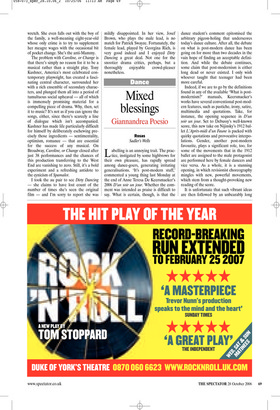Mixed blessings
Giannandrea Poesio
Rosas Sadler’s Wells
Labelling is an annoying trait. The prac tice, instigated by some highbrows for their own pleasure, has rapidly spread among dance-goers, generating irritating generalisations. ‘It’s post-modern stuff,’ commented a young thing last Monday at the end of Anne Teresa De Keersmaeker’s 2006 D’un soir un jour. Whether the comment was intended as praise is difficult to say. What is certain, though, is that the dance student’s comment epitomised the arbitrary pigeon-holing that underscores today’s dance culture. After all, the debate on what is post-modern dance has been going on for more than two decades in the vain hope of finding an acceptable definition. And while the debate continues, some claim that post-modernism is either long dead or never existed. I only wish whoever taught that teenager had been more careful.
Indeed, if we are to go by the definitions found in any of the available ‘What is postmodernism?’ manuals, Keersmaeker’s works have several conventional post-modern features, such as pastiche, irony, satire, multimedia and quotations. Take, for instance, the opening sequence in D’un soir un jour. Set to Debussy’s well-known score, this new take on Nijinsky’s 1912 ballet L’Après-midi d’un Faune is packed with quirky quotations and provocative interpolations. Gender, another post-modern favourite, plays a significant role, too, for some of the movements that in the 1912 ballet are assigned to the male protagonist are performed here by female dancers and vice versa. As a whole, it is a stunning opening, in which revisionist choreography mingles with new, powerful movements, which stem from a thought-provoking new reading of the score.
It is unfortunate that such vibrant ideas are then followed by an unbearably long series of unimpressive dance images that stand stylistically in-between some diluted, old-fashioned modernism and a tired regurgitation of Keersmaeker’s own work — sharp, angular and angst-permeated movements. The tiresome, uninventive action, which continues after the interval with an indigestible choreographic rendition of Stravinsky’s Fireworks, leads wearily on to another revisionist take on Nijinsky/ Debussy, the ballet Jeux. Yet Keersmaeker’s reading of this delicate composition does not have the same impact as her revised Faune, despite some potentially striking ideas — such as the parallel between the ballet’s feeble original plot and a projected sequence from Antonioni’s movie Blow Up. The two-act work, therefore, concludes on a flat note and comes across as an artistically and stylistically amorphous oddity. It may well be ‘post-modern stuff’ in that it is chaotic and inconsistent, but it has none of the typically post-modern bite found in other and more appealing works by the same choreographer.
Luckily, a triple bill of ‘old’ works presented by Keersmaeker’s company Rosas later on in the week confirmed that not all her dance-making lacks stylistic consistency and theatrical linearity. Created in 1986, and set to Bartók’s haunting music, Quatuor No. 4 is regarded by many as one of Keersmaeker’s signature pieces. Its now irreverent, now abrasive action, engagingly performed by four dancers to live music by the Duke Quartet, is often cited and referred to as the manifesto of those European choreographic trends that emerged in the mid-1980s. It still holds the stage beautifully and still has terrific drive. The often frenzied choral movements of the four dancers, their brief pauses, their physical in-jokes provide the viewer with an excellent key to understanding subsequent creations, such as the visually stunning 1992 Die Grosse Fuge, to Beethoven’s music — strategically placed as the second item on the second programme.
Die Grosse Fuge stands out mainly for the visual impact the perfectly calibrated ensemble dancing has on the viewer and for the breathtakingly fluid connection between the dancing itself and the music. Both Quatuor No. 4 and Die Grosse Fuge contrasted vividly, and effectively, with the final item, the 1995 Verklärte Nacht, to music by Schönberg. This is a more narrative piece, which slips now and then into dance-theatre modes and ideas. Unlike the other two, it comes with a set, in which the imagery evoked by Schönberg is clearly echoed. Yet despite the narrative quality mentioned earlier, there is no proper story, only a series of lyrical, dramatic and somewhat unsettling images that enhance and complement the fading late romanticism of the score. Regardless of any definition or label, this is theatre dance at its best, and makes one forgive Keersmaeker for creations such as D’un soir un jour.



























































































 Previous page
Previous page